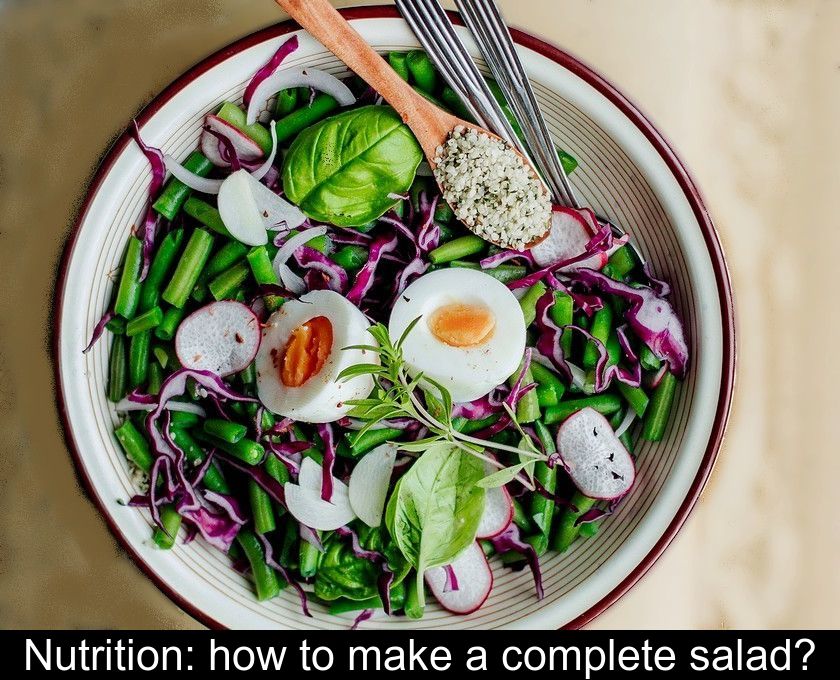Nutrition: How To Make A Complete Salad?
Salads are one of the easiest recipes to prepare a meal with ingredients from the fridge and without turning on the oven. They're also convenient to take with you if you're eating out, on a picnic or at work. But are you sure you know how to make perfectly balanced salads? If you want to make a balanced meal out of a simple salad, here are 5 tips for making a complete salad.
1- Don't skimp on raw vegetables
The cooked vegetables and crudités are the foundation of successful mixed salads.
The first rule of composing a complete salad that constitutes a balanced meal is not to skimp on raw vegetables.
You can be generous with raw or cooked vegetables as they have multiple nutritional qualities. They are rich in fiber and nutrients and low in calories.
Not only can you use them without moderation, but you should also make sure to put several in your salad. Remember to vary the colors and favor seasonal vegetables to fill up on good nutrients!
In summer, you can enjoy tomatoes, peppers, zucchini and cucumber. In winter, opt for green salad, grated carrots, endives and avocado.
2- Don't forget starchy foods
Sometimes we forget about them, but starchy foods are the second essential component of a complete salad.
Even if you're watching your weight, you shouldn't skip starchy foods because they provide complex carbs and keep you full for a long time.
Their presence in the salad (or next to it in the form of bread) is necessary to compose a perfectly balanced meal.
The only dietary rules to follow are:
- put in smaller quantities than raw vegetables, so as not to turn your salad into a pasta dish
- do not combine several sources of complex carbohydrates in the same meal, for example pasta and bread
To compose your salads, you will be spoilt for choice between pasta and cooked rice, but also bulgur, toasted bread croutons, cooked potatoes, sweet potato, lentils, red beans or broad beans.
3- Add protein
Protein is another component of a complete salad, but that doesn't mean you have to add chicken pieces or bacon to your salad.
If you're a vegetarian or flexitarian, know that you can use either animal or plant-based protein.
Protein sources are numerous so think about alternating between chicken, diced ham, hard-boiled eggs, but also canned tuna or salmon...
For vegetarians, always add legumes like lentils, chickpeas or kidney beans, or Quinoa or tofu to your raw salads.
4- Think about calcium and essential fatty acids
To achieve your goal of eating balanced with a simple salad, you need to add a source of calcium and a little bit of fat to your mixed salads.
In practice, if you don't eat a piece of cheese or yogurt with your meal, you can add to your whole salad :
- either the equivalent of a portion of cheese (i.e. 25 to 30 g of cheese such as shavings of Parmesan or diced Emmental or Mimolette cheese)
- or calcium-rich seeds or oilseeds such as almonds or sesame seeds.
The last essential ingredient for a perfectly balanced salad is fat. But you should moderate the amount of fat.
It's also important to vary the sources of essential fatty acids. So even if you're used to making dressing with olive oil, you can try new dressings by incorporating rapeseed oil, walnut oil or flaxseed oil.
These three lesser-used vegetable oils are interesting because of their richness in omega 3, which is essential for good health.
5- Be creative
Now that you know the process of putting together a full salad, the last tip I can give you is to diversify the ingredients you put in your salads so you don't get tired of them.
One of the keys to making salads more appealing is seasoning. On that note, it is of course advisable to limit the amounts of salt and use other condiments like herbs and spices.
To vary the flavors, consider sprinkling your salads with chives, dill, fresh basil, cilantro or snipped parsley.
Also consider incorporating spices like curry and turmeric into your dressings and spicing up your sauces with fresh garlic, onions, shallots and mustard.
To bring a sweet and original touch to your salads, you can also incorporate fruit, especially if you like sweet and sour dishes.
Depending on the season, you can add diced mango, pineapple or Granny Smith apple, grapes or even fig wedges to your salads!
Here is a delicious recipe for a salad with fresh figs.











